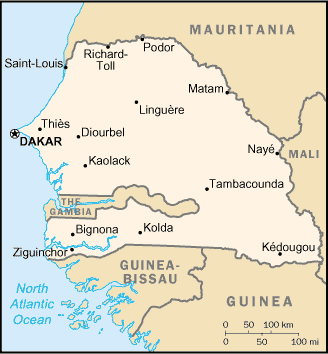Senegal
Map Courtesy CIA World Factbook
Islam, the dominant religion in Senegal, first came to the region in the 11th century. Of the native kingdoms, the Jolof Empire of the 14th century was the most powerful. Various European powers came to the area from the 15th century onward, until France ended up in possession of what had become an important slave trade departure point. Dakar became the capital of the French colony of French West Africa in 1902. In January 1959, Senegal and the French Sudan merged to form the Mali Federation, which became fully independent on June 20, 1960, as a result of the independence and the transfer of power agreement signed with France on April 4, 1960. Due to internal political difficulties, the Federation broke up on August 20, 1960. Both Senegal and French Sudan (renamed the Republic of Mali) proclaimed independence individually. Senegal joined with The Gambia to form the nominal confederation of Senegambia in 1982. However, the envisaged integration of the two countries was never carried out, and the union was dissolved in 1989. Despite peace talks, a separatist group in the southern Casamance region has sporadically clashed with government forces since 1982. Senegal has a long history of participating in international peacekeeping.
|
|||||||||||||||
 The Republic of Senegal is a country south of the Senegal River in West Africa. Senegal is bounded by the Atlantic Ocean to the west, Mauritania to the north, Mali to the east, and Guinea and Guinea-Bissau to the south. The Gambia forms a virtual enclave within Senegal, following the Gambia River more than 300 km inland. The Cape Verde islands lie some 560 km off the Senegalese coast.
The Republic of Senegal is a country south of the Senegal River in West Africa. Senegal is bounded by the Atlantic Ocean to the west, Mauritania to the north, Mali to the east, and Guinea and Guinea-Bissau to the south. The Gambia forms a virtual enclave within Senegal, following the Gambia River more than 300 km inland. The Cape Verde islands lie some 560 km off the Senegalese coast.